In the first months of 2019, just before the World2 Tour was set to begin, I purchased the most expensive visa I had ever heard of. Specifically, one that would permit me to enter the largest country in the World, in terms of land area, and it was not a simple matter. Being extremely large, my Tour in that country, while it would not have been a total crossing by bicycle, was still expected to be fairly lengthy, and because I also planned to visit at least two neighboring countries, I needed to obtain a three-year, multi-entry visa, the most expensive type available. Additionally, since said country did not have an online application process in place, I would need to send my passport to the embassy in Washington for the application, further complicating matters. Furthermore, since I would also need to have my passport available for a shorter, pre-Tour trip in the following weeks, I was forced to use a visa broker service and pay extra for expedited processing, pushing the cost up even more. The result was that, just for the ability to ride a few meters across some imaginary line, I had to expend over five hundred US Dollars.
Not surprisingly, when border closures started to happen in early 2020, I was concerned and disappointed, not only because of the effect that skipping that country was going to have on the Tour, as a whole, but because I hated to think that such a large expense was going to go to waste. Later that summer, flights to that country from a few destinations were started again, so I attempted to get in that way. As I wrote about at the time, that effort didn’t work, and I got only as far as the airline check-in counter before being turned back. Moving ahead to the Coda section, after I officially ended the Tour in New Caledonia, I unexpectedly found myself needing to return to Western Europe in order to take the only operating flight to the Ultimate Destination (though if I had simply waited another month, or so, more direct options would have been available.) Not wishing to let such an opportunity go to waste, I decided to make a few non-touring visits to some of the interesting places that I had been forced to skip two years earlier. Since the visa I already had for that particular large country was still valid, I intended to try again, making a relatively short stop there with the intention of seeing several of that country’s often excellent World Heritage Sites. As late as the second week of February, 2022, that option was still in play. Then that #@¿\$!* skunk Putin personally decided to destroy one of the more pleasurable countries I saw during the early part of the Tour, and that settled that. Even if it had still been logistically possible, which it wasn’t, I no longer had any desire whatsoever to spend any time in said country.
When my first attempt to make that visit failed in the summer of 2020, I came up with an alternate plan to go to Uzbekistan, instead. In fact, it did not take long for that remote Central Asian country to captivate my attention, even more than my original route plan had done. However, for reasons that never really became clear to me, I was, once again, denied boarding at the airport while trying to travel there. Skipping ahead, past the major reorganization of my route that ensued, once I had started the Coda section of the Tour the next logical stop, after Mongolia, would have been the large county alluded to above. However, even then, news reports were casting doubts over any potential visit there. Once again, Uzbekistan was my Plan B, should catastrophe befall Ukraine, which, sadly, was exactly what happened. As before, the thought of seeing the interesting country of Uzbekistan, primarily for four of its top-level World Heritage Sites, actually became more appealing to me, so I was fine with that change. Another thing that I was fine with was that, in early April, I would be experiencing glorious springtime weather for once, as opposed to one extreme or the other, as had been the case for the previous eighteen months. In that regard, I could actually have continued the cycling part of the Tour there without much difficulty, which would have been great. However, due to the relatively short amount of time I was realistically able to commit to for that stop, I couldn’t really do a tour that would be satisfactory, so I had to fall back to another, more traditional, type of trip once again.
To make arrangements for that, I would need to spend a couple of days in the capital city, Tashkent, and, once again, apart from the fact that the only flight option to get there involved traveling via Incheon—beginning by going in the wrong direction, something I really dislike—the entry process seemed generally normal. I did need another PCR test to leave Mongolia, but Uzbekistan had lifted almost all covid-related policies and procedures and, I have to say, it felt very refreshing to live that way for a while again. Tashkent seemed like a fairly interesting city to me, though it would not really be a compelling destination on its own. It had been largely destroyed by an earthquake in the 1960s, at a time when Uzbekistan was still incorporated into the USSR, and had been rebuilt with a rather distributed plan, though I was not really sure how much of the city was built after independence, or earlier, by the Soviets. The former seemed more likely, since there was a distinct Modernist style to much of the cityscape. At night, many of the newer buildings were decorated with animated, polychromatic LED lighting displays, however, there was a notable absence of hyperbolic vanity monuments to former leaders, of the type that can be found in other new
Central Asian capitals, like Ashgabat and Nursultan. One aspect that caught my attention was that Tashkent seemed like one of the quietest, in the actual sense of the word, large cities I can remember. There were always plenty of generally happy people out and about, but with relatively little shouting, playing of loud recorded music, or similar audible clutter. Motorized traffic was, of course, usually present, but without many excessively noisy vehicles, rarely jamming up the streets, and without any obnoxious horn honking. These are urban characteristics I could really get behind.
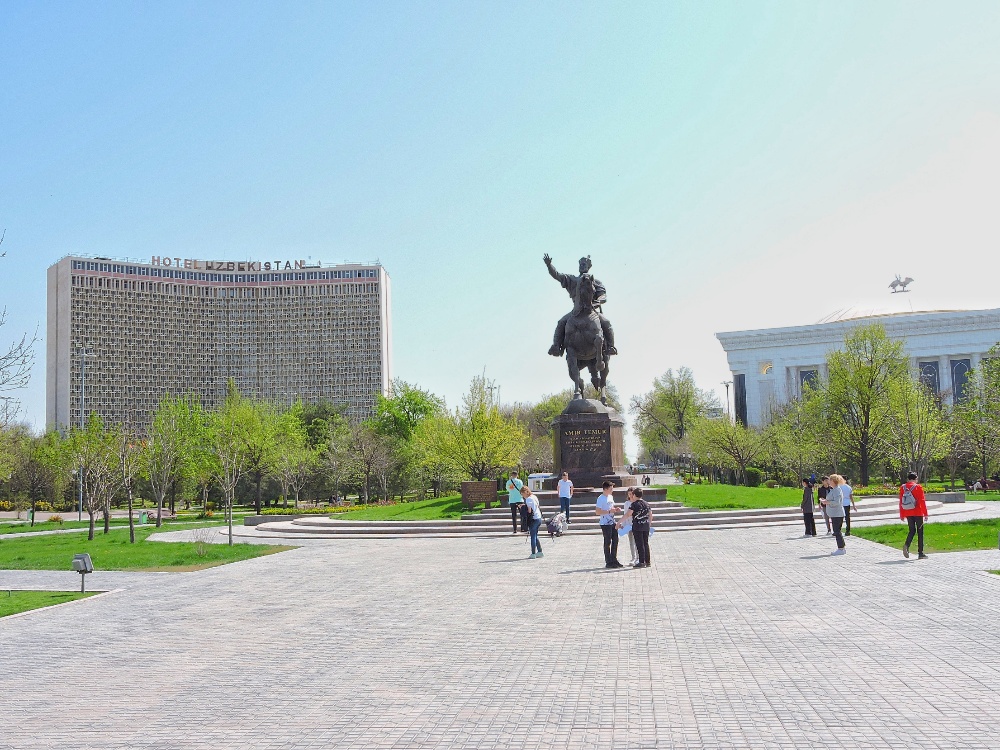
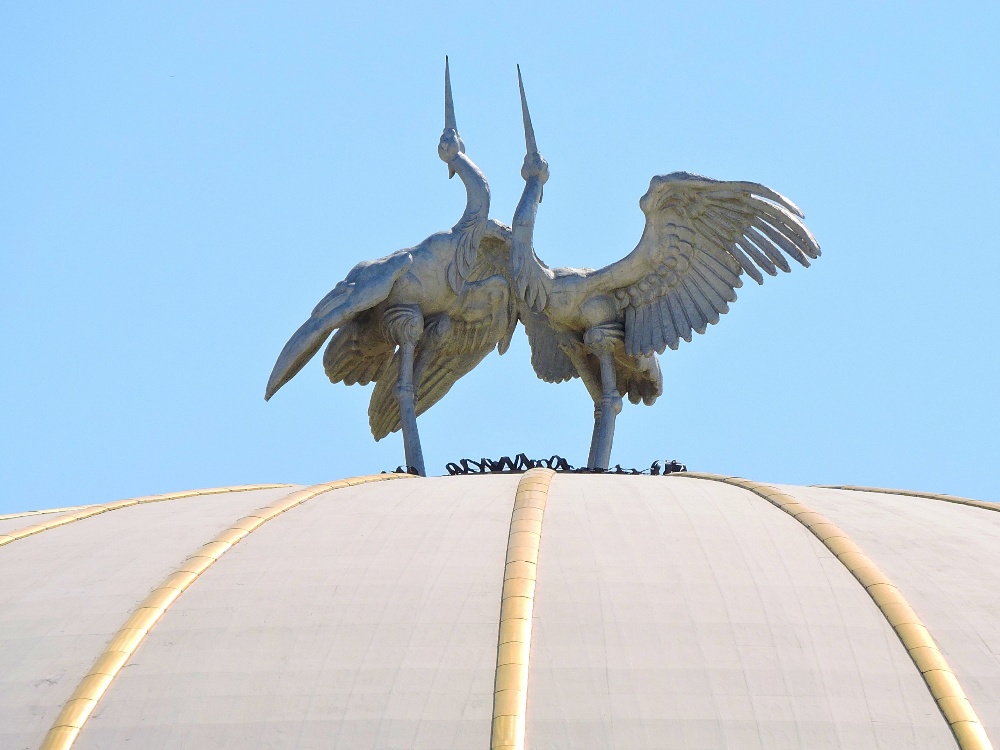
After spending most of the previous four weeks being led around by tour guides, it was quite refreshing to be able to move around independently again. My intention was to see the country's four World Heritage Sites in the Cultural category. To do that, I would go to the ancient cities of Samarkand and Bukhara, each of which is a listed Site, and visit the remaining two Sites by day trips from those bases. Fortunately, I was able to do that in an efficient manner, because Uzbekistan has an extensive and convenient passenger rail network, the most advanced such system in Central Asia. The equipment consisted of slower, Soviet-era, rolling stock but also recently-added higher speed trains, which have been given the ancient name of Samarkand, Afrosiyab. I utilized both services, which were well-run, timely, and did not present any problems for brining my packed bike along.
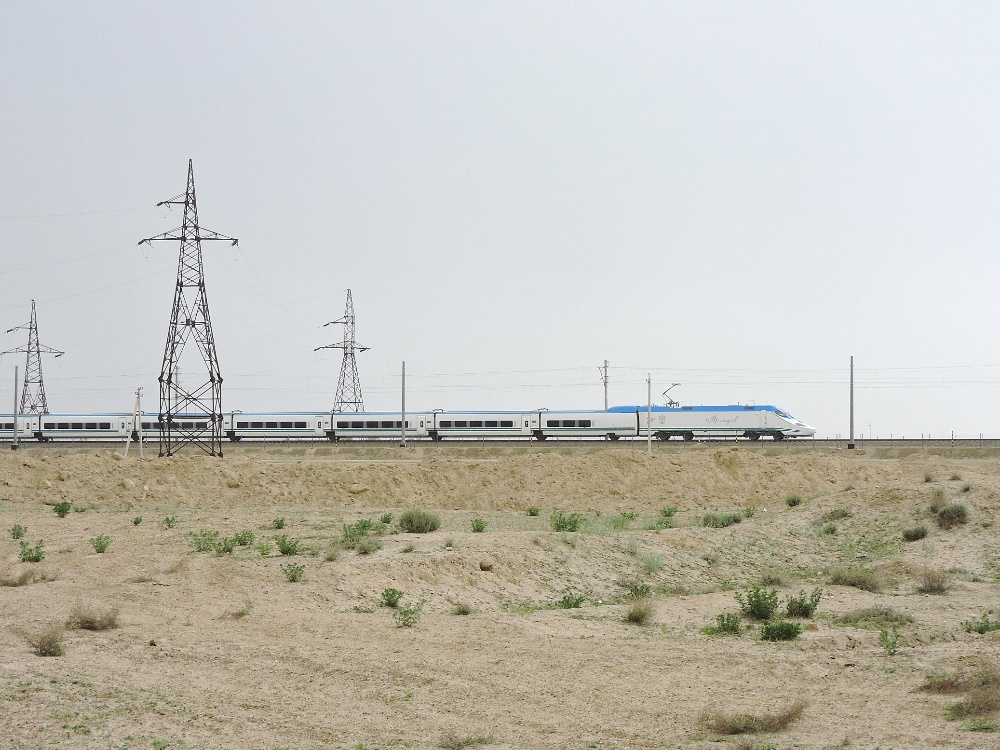
During those rail journeys, as well as the rest of my time in the country, I tried to observe what the conditions for cycling would have been, had I actually been able to tour there, assuming the 2020 visit had happened after all. There were definitely a lot of paved roads present, for a generally arid country with a fairly small population. However, it seemed to me that most of them were built by the Soviets, using the lower standards of that era, and have not received much in the way of maintenance or improvements since then. I could only get occasional glimpses of the major intercity roads through the windows of the trains, and most of what I saw made me think that traffic was often rather heavy. Additionally, as a country consisting primarily of long, flat valleys, punctuated with an occasional low ranges of hills, there were not really a great number of routing choices available, so had I been touring there I probably would have been required to use less than perfect routes, at least for part of the time.
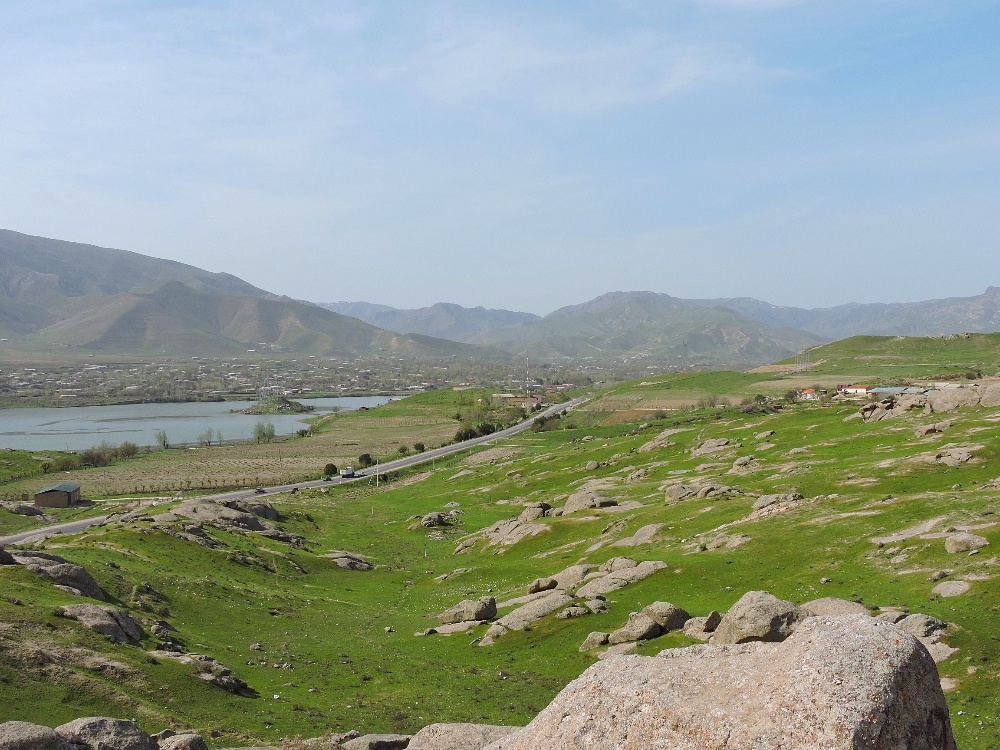
However, unlike Mongolia, where the frigid temperatures prohibited any cycling whatsoever, the beautiful weather of April in Uzbekistan caused no such problems. While I did not have a great deal of time available, I was determined to do a little cycling while I was there. Therefore, I reassembled the bike in Bukhara in order to do two short rides. That was a wholly inadequate amount of cycling, given the two month duration of the Coda section, but it was better than nothing, and it made Uzbekistan the seventy-eighth country in which I have done at least some bicycling.
I really enjoyed seeing Uzbekistan, and I am sure that I would have very much enjoyed touring there as well. After a few difficult years following independence, the country is now probably the most developed and stable of all of the ‘Stans, with good infrastructure, tasty food, and universally friendly and polite people. These days the impression is more distinctly Silk Road, as opposed to Soviet Union. Given the horrible events going on in Ukraine at the time of my visit, I didn’t feel it would be a good idea to bring up the topic of that earlier period of time when speaking with the local people. Indeed, most of the younger residents today have no personal recollection of that era and the older generations seemed to me to treat it as something that was endured and then moved on from. Only a few dimly nostalgic aspects can be found here and there, such as this selection of old award pins and medals for sale at an antique shop, or some Cosmonaut-themed ice cream.
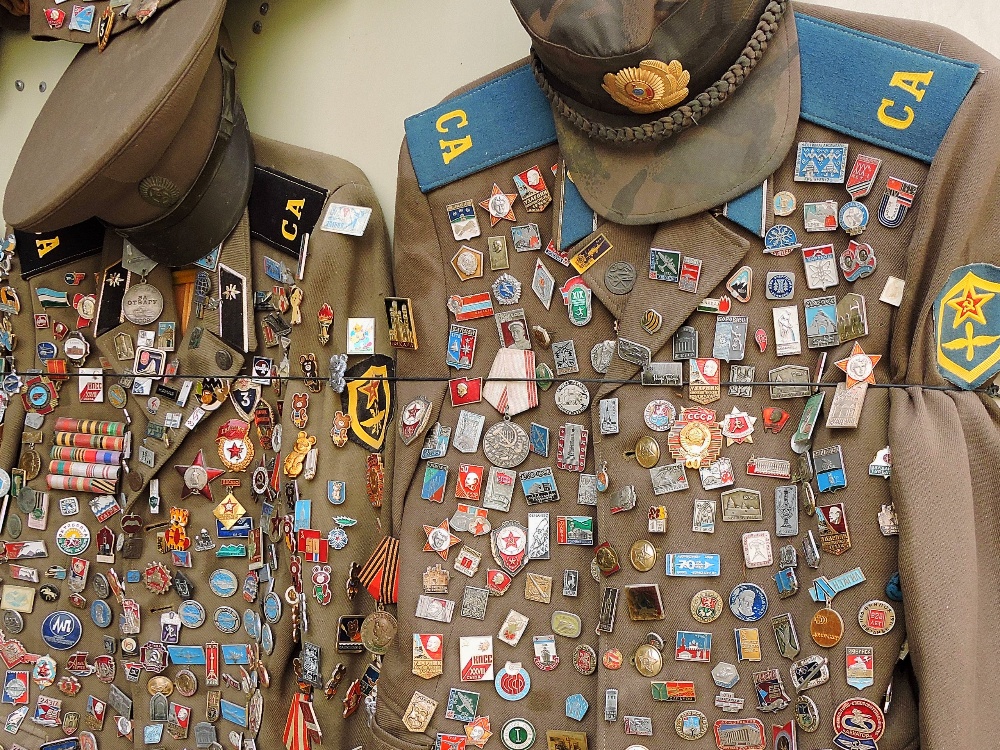
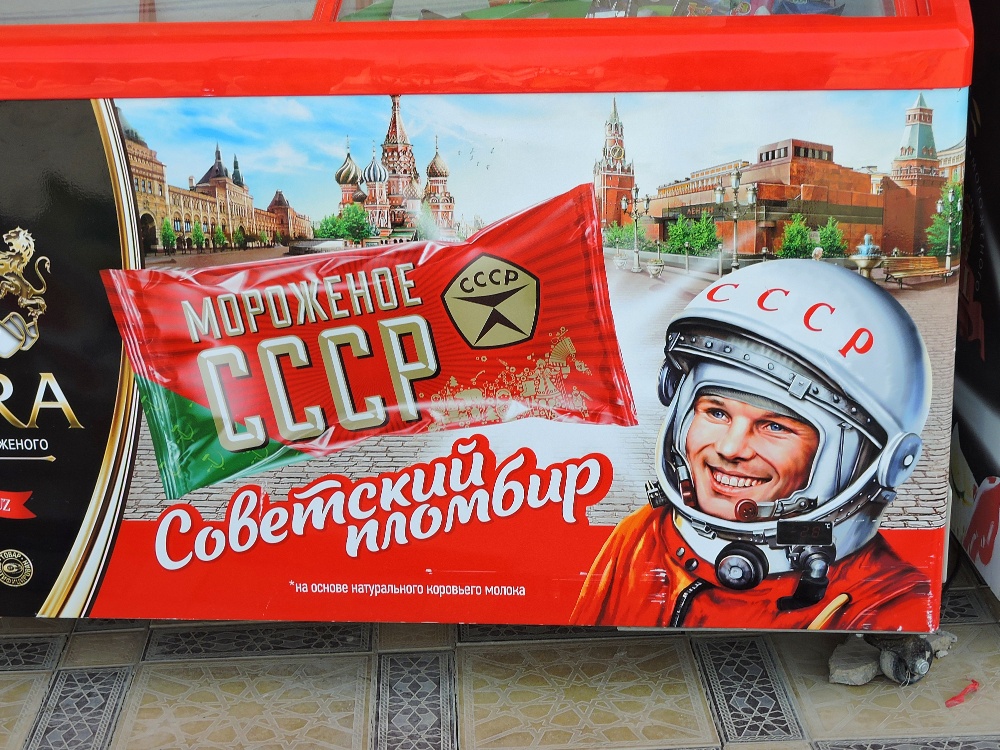
In an earlier post, around a year ago, I wrote:
When the World2 Tour completed its first year, on April 08, 2020, I was uncomfortably inactive during a rather loose Lockdown, in Berlin. Upon its second anniversary, on April 08, 2021, I was similarly inactive, even more so, and even more uncomfortable, during a more strict quarantine, in Bangkok. Neither situation, of course, had been included in my original plans for the Tour. There is essentially no possibility that the Tour will still be underway when that date rolls around the next time. However, given the way the past fifteen months have unfolded for all of us, I should probably not be so sure about that. Accordingly, it might be prudent for me to examine the possibility of making advance arrangements to be inactive and uncomfortable next April in another capital city whose name begins with B, perhaps Bandar Seri Begawan, or Bogota.
As often happens, I may have spoken too soon on that occasion. In late March of 2022, though the cycling portion of the Tour had ended, I was actually just eighty-five kilometers south of Bandar Seri Begawan, in Sarawak, Malaysian Borneo. A short time later, when April 8, 2022 brought the third anniversary of the start of the Tour, I was in Bukhara, a city whose name starts with B and though it is not now a capital city, in the past it did hold that status for the the Samanid Empire, and later the Khanate of Bukhara, until around two hundred fifty years ago. Close enough. This time, however, things are really certain. There will be no fourth anniversary somewhere else, as the World2 Tour is officially complete.
Slava Ukraini!!